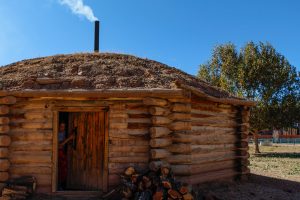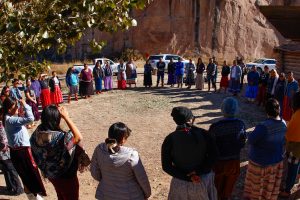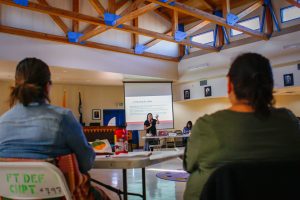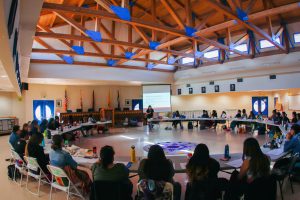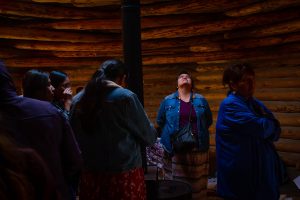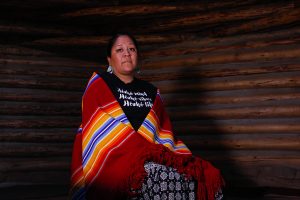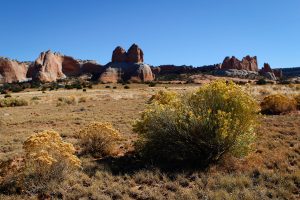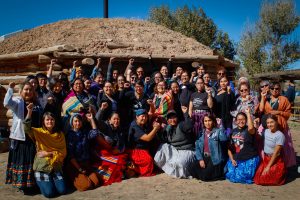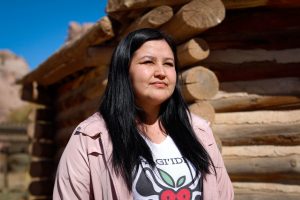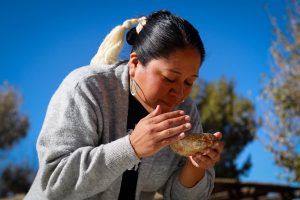- Slug: BC-CNS Maternal Mortality, 2,695 words.
- 10 photos and captions below.
- 4 graphics here, here, here and here.
By Kyley Warren
Cronkite News
WINDOW ROCK – As the sun begins to set on a blustery fall day, the rugged buttes of Navajoland glow red in the soft light and swift gusts spiral dust through the air.
About 40 women, most draped in traditional dress, stand in a circle as Melissa Brown, an indigenous midwife, asks the group to reflect on the day just ending – and the mission still ahead.
“We have talked about being safe here. That is our goal,” she tells them. “We’re going to cry, and we’re going to laugh. And that’s OK.”
One by one, the women share a word that best captures how they feel: Happy. Safe. Joyful. Supported. Sovereign. Brave. Then one sings a hymn in her native tongue.
These women have come to the Navajo reservation to be trained as doulas, aides who have no formal medical background but provide guidance for pregnant women up to and through labor, and sometimes beyond.
They’re here in Window Rock, capital of the Navajo Nation, to learn how to help their own, but also to help confront a tragedy plaguing women in Indian Country and across the United States.
Too many women are dying due to complications from pregnancy and childbirth – deaths that should be preventable with the right intervention and care.
“My first birth that I had when I was a teenage mother was very traumatic,” said Brown, who trains indigenous women as midwives and doulas across the United States and Canada. “I didn’t understand how my body worked … how labor and delivery worked. I was very scared, and I didn’t have much support.”
Now, she said, “people are recognizing that we are our own experts in our community. We can help ourselves. We can empower ourselves. We can educate ourselves.”
An American crisis
It’s a grim statistic, and one that’s often recounted: American women are more likely to die of childbirth or pregnancy-related causes than other women in the developed world.
And although recent investigations have drawn the attention of Congress and put a national spotlight on the issue – especially among black women – Native Americans often are left out of the conversation.
American Indian women are more than twice as likely to die from pregnancy-related causes than white women and lag behind only black women as those most at risk, according to federal statistics.
From 2011 through 2016, according to the Centers for Disease Control and Prevention, the ratio of pregnancy-related deaths among American Indian and Alaska Native women was 30.4 deaths per 100,000 births, compared with 13 deaths per 100,000 births for white women and 42.4 deaths for black women.
In Arizona, maternal death rates are highest among Native American women: 70.8 deaths per 100,000 births.
Overall, the U.S. maternal mortality rate jumped to 16.7 deaths per 100,000 births in 2016 from 7.2 deaths per 100,000 births in 1987.
As many as 60% of these deaths are preventable. Nevertheless, about 700 women in America die each year due to complications of pregnancy – and for every death, there are many more women at risk.
The CDC defines a pregnancy-related death as the death of a woman while pregnant, or within one year after pregnancy, from any cause related to or aggravated by the pregnancy or its management, but not from accidental or incidental causes.
“If you look at the timing of the death, it’s actually a small proportion of them (20%) that are happening around the day of delivery,” said Dr. David Goodman, co-author of a CDC study on racial disparities in maternal mortality.
When searching for ways to prevent these deaths, Goodman said, “It’s not just what could have been done in that hospital at that time. It takes into consideration what is happening in the community in which that patient lived that may have contributed, and what is happening within systems of care.”
For American Indian women, hemorrhage and hypertensive disorders of pregnancy are among the biggest contributors to these deaths, according to the CDC. In addition, lack of access to proper health care particularly affects American Indian and Alaska Native women.
Ramona Antone-Nez, senior epidemiologist at the Navajo Epidemiology Center in Window Rock, specializes in data collection and works to identify health priorities and concerns within the Navajo Nation.
She notes that the reservation – the nation’s largest, spanning more than 25,000 square miles across Arizona, Utah and New Mexico – typifies some of those accessibility issues that can hamper a woman’s care.
“For the majority of our population, the hospital isn’t just around the corner, just around the block. … A lot of our care takes probably an hour or so just to get to,” Antone-Nez said, adding that a lack of access to specialized care for high-risk pregnancies is another problem.
As a result, many women may miss screenings, prenatal checkups and other appointments at which early problems might be identified.
Nicolle Gonzales is a nurse midwife and the founder and executive director of Changing Woman Initiative in Santa Fe, New Mexico. The group provides care for pregnant Native women and organized the October doula workshop in Window Rock.
Gonzales, who is Navajo, said women should have 10 to 12 prenatal visits before delivery, but indigenous women are lucky to have half that many.
“That makes it difficult to identify health problems like diabetes and hypertension and obesity, or a baby that’s not growing well in the uterus,” she said. “So there’s a lot of missed opportunities to screen for things that could come up in pregnancy.”
Congress and numerous state legislatures have taken steps recently to address these deaths.
In December 2018, President Donald Trump signed the Preventing Maternal Deaths Act, authorizing the CDC to help support maternal mortality review committees established by states and tribes to collect more data about what’s happening and identify possible solutions. A first round of grant money was awarded in August to 25 states, including more than $2 million over five years to the Arizona Department of Health Services.
Also this fall, U.S. Rep. Xochitl Torres Small, D-N.M., introduced legislation meant to specifically help women in rural America by expanding federal telehealth programs to include birth and postnatal services and further identifying gaps in care.
“For pregnant women in rural districts … they often have to spend hours on the road and cross state lines to attend the necessary prenatal appointments,” Torres Small said in announcing the bill. “Expectant mothers should have the peace of mind that no matter where they choose to start a family, they will have access to the resources they need to bring healthy babies into the world.”
In April, Arizona Gov. Doug Ducey signed legislation establishing an advisory committee to work with the state Department of Health Services to produce annual reports about maternal deaths and identify solutions.
The committee first convened in August, and this month is finalizing a report that includes recommendations for improving the timeliness of maternal death identification, establishing partnerships so that records are more quickly shared and finding ways to partner with tribes and the Indian Health Service to better understand the underlying risks to Native mothers.
Committee member Breann Westmore is director of government affairs and maternal child health for the Arizona chapter of March of Dimes, a nonprofit that works to improve the health of mothers and babies. She said the state hadn’t examined maternal mortality data since 2015.
“We didn’t have some of the pieces in place to be looking at this data real time,” she said. “That’s one of the solutions we’re starting to look at … so hospitals can be doing quality improvement instead of retrospectively looking at (old) data.”
March of Dimes is rolling out training on implicit bias to also try to address the problem. (California approved a law this fall requiring all health care providers involved in perinatal care to receive such training.) The organization also has a mobile health unit in Tucson to assist rural areas.
But even in communities where accessibility is less of an issue, the approaches of Western medicine often don’t align with the values and practices of Native American culture.
Brown, the midwife, said this alone can prevent women from asking questions and seeking the necessary support to better understand pregnancy and labor.
“We’re bringing nonindigenous people who don’t have that lived experience into communities and … delivering health education in a way that doesn’t make a lot of sense to people in the community,” Brown said.
“Something needs to change, not only here but in other indigenous communities. And I think that’s why … you see this big resurgence with indigenous reproductive justice work and indigenous birth work.”
Yiya Vi Kagingdi: ‘Mother’s Helpers’
Brown’s own experience with labor inspired much of her work as a midwife.
Pregnant as a teen with her first daughter, Brown was induced for two days with medication to strengthen her contractions. She remembers the doctor at one point telling her she had 20 minutes to get the baby out or would otherwise have a cesarean section.
After her daughter finally was born, Brown suffered a hemorrhage and later battled postpartum depression.
“There’s definitely places for (Western medical) interventions,” she said, “but we need to be able to explain to people what’s happening in their bodies … and what those risks and benefits are and what some alternatives are.”
For her second pregnancy, Brown relied on an indigenous midwife. Brown soon began helping other pregnant women, then trained as a doula and eventually became a midwife. Part Navajo and Anishinaabe, Brown now runs Zaagi’idiwin, a doula training and maternal health organization based in Winnipeg, Canada.
Gonzales, of Changing Woman Initiative, was 20 when she had her first child, and she remembers facing false assumptions about her marital status and non-Native doctors who would barely speak to her.
She later worked as a nurse for Indian Health Service in Santa Fe, an experience that pushed her to become a midwife and work with other Native women.
“I saw Native women not having agency or support during their childbirth experiences, while midwives who were not Native who served them came away from those births patting themselves on the back,” Gonzales said.
She founded Changing Woman in 2015 with the goal of building a new birthing facility specifically for Native women. As that work proceeded, she began caring for women in their homes, which helped her better understand some of the barriers to receiving proper care throughout the birth process.
“The access issue and the transportation issue go hand in hand for us,” she said. “Some women don’t have a driver’s license. Some don’t have transportation or a car. Some don’t know how to drive.
“So how do we reach those populations … and give them the quality care they deserve, without making them fit into this medicalized way of taking care of ourselves?”
Today, the organization focuses on three areas: reproductive health, home births and an easy-access clinic that offers immediate care regardless of whether a woman has proof of insurance.
The group targets indigenous women living in or around Santa Fe, Albuquerque and the Navajo reservation, as well as the pueblos of Pojoaque, Tesuque, Santa Clara, Ohkay Owingeh, Nambe, Picuris, Taos, Jemez, Santa Domingo and San Ildefonso.
The organization also is collaborating with Native farmers to support prenatal and postpartum patients by providing nutritional assessments, classes and food baskets. Gonzales’ home clients get free groceries once a week, she said.
And fundraising continues for a traditional birth center in Pojoaque, New Mexico, that would offer culturally appropriate well-woman care, birth services and postpartum support groups.
In New Mexico, where 20% of the 97 maternal death cases identified from 2010 to 2014 involved Native women, Gonzales’ group is just one organization led by Native women working to improve maternal health.
Founded in 1989 and based in the ancestral Tewa homelands of northern New Mexico, Tewa Women United provides doulas at low or no cost and offers prenatal and postpartum care.
The effort is called Yiya Vi Kagingdi, which in Tewa means “Mother’s Helpers.”
The group’s work came out of a survey of Tewa women. Of the 131 who responded, 49.6% wanted their cultural practices to be more a part of their birthing experience, 44.1% felt their prenatal care providers were not culturally sensitive, and 41.7% felt that their labor and delivery staff were not culturally sensitive. An additional 39.3% reported wanting prenatal care in their homes.
“Doulas have always been something that our community has had – whether it’s through our sisters or our aunties or women in our community who have that role traditionally,” said Jessica Lujan, who oversees the women’s health program at Tewa. “So we didn’t want to just claim the word ‘doula.’ We wanted to really say that Yiya Vi Kagingdi is something that has always been here.”
Reconnecting, revitalizing
Although some of the women gathered in Window Rock had left the reservation long ago, all shared at least one thing: Navajo roots.
“There’s so many powerful people here,” Brown said. “There’s environmental scientists, political scientists, nurses, midwives. There’s medicine people, knowledge-keepers. There’s people who work in reproductive justice.
“It’s really kind of reconnecting and revitalizing the knowledge that’s already here. We’re not teaching anybody anything new – we’re just reconnecting them with things that are in their community.”
Pam Malone was there to learn how to be an emotional support aide for women throughout their pregnancies. She was inspired after helping her sister during labor – a duty she took on after her mother died.
“That kind of put me in this place of wanting to give back,” said Malone, a program manager at Northern Arizona University in Flagstaff who has no medical training.
Another trainee, LaKota Scott, is in her fourth year at National University of Natural Medicine in Portland, Oregon, and plans to work in women’s health. Her goal was to learn how to incorporate traditional practices into her training.
“There’s a lot of Native people that live in Portland, but the care you actually get as a Native person is very poor usually, especially in urban areas,” she said. “By having somebody there to educate you and support you through that, you can reduce a lot of that fear and educate them more about their bodies.
“And that’s really important for Native women, or just women in general.”
Becki Jones, a program manager at Planned Parenthood in Albuquerque, wanted to become more knowledgeable about reproductive health through a “traditional lens” and pass that on to colleagues back home.
“It’s just nice sharing this space where it actually feels safe, where I can ask any question,” Jones said. “I’m getting this knowledge, and it’s sacred knowledge and it’s so beautiful. It’s building a revolution for us. We’re taking back and reclaiming our knowledge and our sovereignty and our autonomy.”
Throughout the four-day training, the women learned some of the basics of doula work, such as understanding the stages of pregnancy and creating care plans. They also discussed using cultural meditations to help with contractions and such traditional practices as placenta and umbilical cord burials – meant to symbolize a child’s connection to Mother Earth.
But the workshop went far beyond all that.
They shared personal stories of grief and loss. They found connection through motherhood, and how the effects of colonization have complicated their ability to effectively address women’s health struggles.
They bonded over the importance of simply having such discussions – often considered taboo in the culture.
“We might hear from our elders that we’re not supposed to talk about death,” Gonzales said. “And so to have a really frank conversation about death and miscarriage and abortion and pregnancy was really the heart of the issue.”
Most importantly, she said, the women felt “held and heard” by one another.
“A lot of the conversations I have with women … issues come up around not having support and feeling like they’re invisible or they’re alone,” Gonzales said. “Being in a space like this really reinforces that we are beautiful, spiritual beings.
“I wish the world would see Native women like that,” she said, “that we’re not sick, we’re not dying, we’re not vulnerable … we’re not our disease, we’re not our social structure.
“That’s our true self.”
To see and hear the birth stories of several Native American women, visit the Changing Woman Initiative’s digital stories page here.
Cronkite News photographer Delia Johnson contributed to this story.
For more stories from Cronkite News, visit cronkitenews.azpbs.org.
^_=
